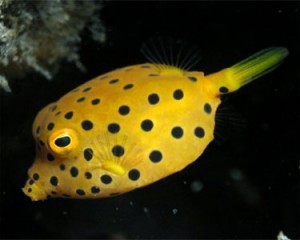| Quick Facts :: Cubicus Boxfish | |
| Care Level: | Difficult |
| Temperament: | Semi-Aggressive |
| Maximum Size: | 18″ |
| Minimum Tank Size: | 125 Gallons |
| Reef Compatible: | Yes, with caution |
| Water Conditions: | 72-78° F, dKH 8-12, sg 1.020-1.025, pH 8.1-8.4 |
| Diet: | Omnivore |
| Origin: | Indo-Pacific to Southeast Atlantic |
| Family: | Ostraciidae |
| Species: | Boxfish |
| Aquarium Type: | Reef Compatible |
The Cubicus Boxfish is found inhabiting coral and rocky reefs in tropical and temperate marine waters of the Indo-West Pacific, including Indonesia, New Guinea, north to the Philippine Islands and east to Fiji and French Polynesia. Larval fish generally settle on sheltered rocky and coral reefs in the summer months, when juveniles are often found in small aggregations. Within the aquarium hobby the Cubicus Boxfish is also referred to as the Yellow Boxfish, Polka Dot Boxfish, or Cube Boxfish. The Cubicus Boxfish is sometimes confused with the Longhorn Cowfish, Lactoria cornuta which is occasionally also called the Yellow Boxfish; however, the Longhorn Cowfish has distinctive horns where the Cubicus Boxfish does not. While many hobbyist are attracted to this species because of their unique look and coloration, they should only be kept by expert aquarists with very large aquariums.
The Cubicus Boxfish is easily recognized by its angular box-shaped body, bright yellow colouration and black spots. Juveniles of the species have fairly large black spots, but as the fish grows, the spots become smaller and brownish, sometimes even changing to white spots with a black margin. The adult of the species has a brownish/grey base color with dots outlined in black and typically grows to around 18 inches in length.
The Cubicus Boxfish is a very difficult fish species to keep in the aquarium setting due to its large size, sensitivity to fluctuations in water parameters and somewhat specialized feeding requirements. An expert aquarist who would like to keep this species should have at a minimum a 125 gallon aquarium, but larger being better. While this species can be kept in reef aquariums, use caution as they will often nibble at tubeworms and if stressed can release a poisonous substance, called ostracitoxin, from its mucous glands which will kill other fish in the tank very quickly. The Cubicus Boxfish will require both large areas to swim and an adundance of rocky caves and crevices (suitable for such a large species to retreat into) in order to be properly housed in a home aquarium.
The Cubicus Boxfish can be a shy feeder when first introduced into the aquarium environment. When first introduced, the Cubicus Boxfish prefers a diet of live foods; such as, brine shrimp, mysid shrimp or bloodworms. However, once acclimated the Cubicus Boxfish will eat a diet that includes chopped squid, clams, mussels, and frozen or flake herbivore preparations. [CREDIT: Aquarium Domain]

